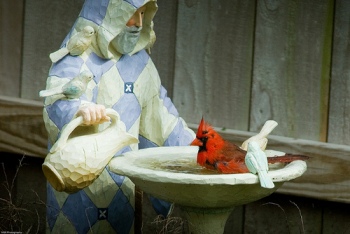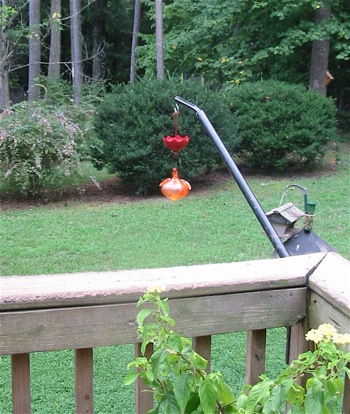-
The hottest july ever?
Sources all over have been telling us this past July was the hottest month on record… ever! As if we don’t know that; by the brown lawns, dying summer flowers, and shriveling leaves. Here’s an interesting article from AUDUBON WINGSPAN: ATLANTIC FLYWAY EDITION on how birds beat the heat.

A cardinal cools off in a birdbath. Photo: Michael Glasgow / CC BY-ND As temperatures bake much of the United States and the nationwide drought continues, crops wither and fish die. But they aren’t the only ones suffering from the blazing summer. Birds are also trying to keep their cool. But they don’t sweat like humans, or even pant like dogs; instead, they have a variety of unique adaptations to help beat the heat.
In a study conducted on marsh sparrows in 2011, scientists found that bill size correlates to outside temperatures. Marsh sparrows with larger bills live in warmer climates, for example. The study noted that the tropical toucan also possesses a large bill, and has the ability to increase or decrease blood flow to its beak to either promote or prevent heat loss.
Laura Erickson of the Cornell Lab of Ornithology, however, points out that the size of a bird’s bill isn’t the only factor that keeps it cool.
“In the case of the raven, the further north you go the bigger their bills are,” says Erickson. “But they need the bigger bill to chip into frozen carcasses in the winter.” Instead, some birds rely on a variety of behavioral adaptations in order to regulate their body temperatures.
Some birds, like the great blue herons that star on the Cornell Lab of Ornithology’s nest cam, will open up their wings on a hot day, allowing air to circulate across their bodies and sweep away the excess heat.
“We’ve watched the adults move their bodies to shade the chicks,” says Erickson. Great blue herons will also “droop” their wings in addition to opening them to protect their nestlings from the sun. But researchers can tell that the posture does more than just keep chicks cool, because the birds also do it when they’re off the nest.
These are only a couple of behaviors that birds use. When it’s hot, some species will also resort to gular fluttering. The bird will open its mouth and “flutter” its neck muscles, promoting heat loss (think of it as the avian version of panting).
“If you think about a dog panting, their tongue isn’t only allowing evaporation, but is losing a lot of body fluid,” says Erickson. “Birds are much more efficient about water and water loss.”
Even so, birds still need to replenish fluids on a hot day. Installing a birdbath can provide feathered friends with a place to cool their heels in the summer, and get a drink. The water level shouldn’t be too high—only about an inch deep—and the bottom of the birdbath shouldn’t be too slippery. Replenish the water once every two or three days. Otherwise, the stagnant water can play host to algae and mosquito larvae, which can carry the West Nile virus as adults.
Almost as important as water is shade. Temperatures can be far cooler under trees or bushes, and birds often seek out these microclimates. Since a bird’s body temperature is much higher than that of humans—a golden crowned kinglet was once found to have a body temperature of 111 degrees Fahrenheit—it’s doubly important for them to cool off in a hurry. Proteins that shuttle vital information to a bird’s organs begin to break apart at temperatures that are only slightly higher.
Climate change is expected to make droughts more frequent and extreme temperatures more common. And some bird populations are already being affected by the consequences of global warming. A study published in the Proceedings of the National Academy of Sciences reported that tree swallows laid their eggs up to nine days earlier because of warmer temperatures in the spring. Several populations of birds, most notably warblers, have also shifted their home ranges northward, and migration patterns are changing to accommodate the change in climate.
Together, these shifts indicate that birds are learning how to adapt to springs that feel like summers, and summers that feel like scorchers.
Related Articles
Ask Audubon: Do birds perspire? -
all seasons wren casita edible birdhouse
 Scorching temperatures and lack of rain have left most of the country in the dust-literally. For wildlife, these extended conditions prove to be daunting. It’s difficult to find food and water, and even more critical when raising young. Birds in our yard have actually been taking seed from feeders to feed fledgelings, Cardinals and Thrashers to be exact. Mother Nature’s device of “survival of the fittest” is in full swing this summer.
Scorching temperatures and lack of rain have left most of the country in the dust-literally. For wildlife, these extended conditions prove to be daunting. It’s difficult to find food and water, and even more critical when raising young. Birds in our yard have actually been taking seed from feeders to feed fledgelings, Cardinals and Thrashers to be exact. Mother Nature’s device of “survival of the fittest” is in full swing this summer.So as far as feeding birds in summer… why wouldn’t you? Food sources are scarce, and supplemental feeding may mean the difference between life or death for some baby birds.
This edible birdhouse provides seeds for lots of resident songbirds. If protected from the elements and squirrels, it should last a while. And even if the seed goes faster than anticipated, you’re left with a real wren house that provides a perfect nesting site for next season. The wooden house beneath the seed may be stained, painted, or left natural. During the “off-season”, the house makes for a great roosting spot too. Appropriately named the “All-Seasons Wren Casita” it makes a fantastic gift for any birder or nature enthusiast… or even for yourself!
Be kind to wildlife and offer fresh water if you’re in a drought-stricken area. A shallow bowl of water makes a swell birdbath, even a plant saucer is great. Just keep water fresh and birds will come!
-
simple bird feeder bracket brings roses closer for smelling!
 The back deck is a perfect place to catch close up views of avian amigos while going about your daily routine. A glimpse out the kitchen or breakfast room window may reveal a little touch of magic that literally takes you out of that routine… if you’re lucky.
The back deck is a perfect place to catch close up views of avian amigos while going about your daily routine. A glimpse out the kitchen or breakfast room window may reveal a little touch of magic that literally takes you out of that routine… if you’re lucky.Since we never have enough time to “stop and smell the roses” – bringing them closer to home makes it easier! Bird feeder brackets are made for decks or walls, and there are lots from which to choose.
Say you don’t want a feeder and messy seeds all over the deck? No-waste seed mixes eliminate mess, or try a hummingbird feeder instead. Ants are a problem with that? Nope… ant moats will take care of pesky ants.
Forget the whole feeder idea and try a birdbath! Fresh water is the most effective way to entice more feathered friends. Using a bird feeder bracket to hang a birdbath works beautifully. There’s no fuss or mess, just keep water fresh for optimal use. And don’t forget to glance out the window every so often, as a one little bird just might bring a big smile 🙂
